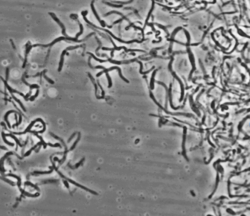Biology:Turicibacter
| Turicibacter | |
|---|---|

| |
| Turicibacter sp. H121 cells under microscope | |

| |
| Turicibacter sp. H121 colonies | |
| Scientific classification | |
| Domain: | |
| Phylum: | |
| Class: | |
| Order: | |
| Family: | Turicibacteraceae Verbarg et al. 2020
|
| Genus: | Turicibacter Bosshard, Zbinden & Altwegg 2002
|
| Type species | |
| Turicibacter sanguinis Bosshard, Zbinden & Altwegg 2002
| |
| Species | |
| |
Turicibacter is a genus in the Bacillota phylum of bacteria that has most commonly been found in the guts of animals.[1] The genus is named after the city in which it was first isolated, Zurich (Latin = Turicum), Switzerland.[2]
Phylogeny
The position of Turicibacter within the Bacillota could not be resolved using 16S rRNA gene-based analyses. However, it was tentatively placed in the class Bacilli, then the class Erysipelotrichia.[3]
In a tree built using a concatenated protein alignment containing data from two draft Turicibacter genomes, the group was placed at the base of the class Bacilli.[4] Later analyses that also included amino acid sequences predicted by a complete Turicibacter genome came to the same conclusion.[1]
See also
- List of Bacteria genera
- List of bacterial orders
References
- ↑ 1.0 1.1 "Complete Genome Sequence of Turicibacter sp. Strain H121, Isolated from the Feces of a Contaminated Germ-Free Mouse". Genome Announcements 4 (2): e00114-16. 2016. doi:10.1128/genomeA.00114-16. PMID 27013036.
- ↑ "Turicibacter sanguinis gen. nov., sp. nov., a novel anaerobic, Gram-positive bacterium". International Journal of Systematic and Evolutionary Microbiology 52: 1263–1266. 2002. doi:10.1099/00207713-52-4-1263. PMID 12148638.
- ↑ Bosshard, PP. "Genus VIII. Turicibacter Bosshard, Zbinden and Altwegg 2002, 1266VP". Bergey’s manual of systematic bacteriology, 2nd ed. The Firmicutes. Springer. pp. 1314–1315.
- ↑ "PhyloPhlAn is a new method for improved phylogenetic and taxonomic placement of microbes". Nature Communications 4: 2304. 2013. doi:10.1038/ncomms3304. PMID 23942190.
Wikidata ☰ Q24892371 entry
 |

